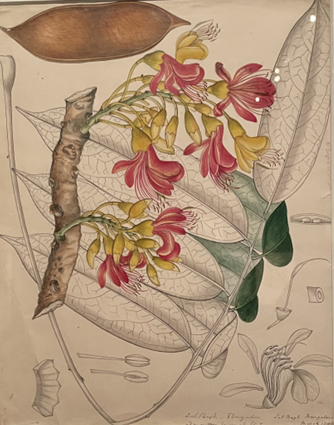Beautiful, delicate, and painstakingly meticulous in their attention to detail, botanical illustrations occupy an oft-overlooked niche of art history because of their scientific function and enduringly traditional technique. ‘Connecting Histories,’ curated by veteran artistic director Emma Nicolson, provides a remarkable insight into the working methods of the 18th and 19th century Indian artists behind the collection. The collection was commissioned primarily by Scottish doctors and botanists employed by the East India Company and are now held by Edinburgh’s Royal Botanic Garden.
Arranged across two small rooms in the John Hope Gateway Gallery, below the expansive café, the compact exhibition is something of a hidden gem. Warmly lit, with a tranquil soundtrack by India Alba – a collective of Indian classical musicians and Scottish folk instrumentalists – an atmosphere of comfortable and considered escapism takes hold.
Wispy stems and perfect, unsullied blooms characterise these graceful and intricate renderings, whose function was to record the appearance of Indian flora when drying and preservation proved a challenge in the humid climate. The role of colonialism in the transportation and trade of these plants, is accessibly explained on large exhibition labels. The labels describe how the European botanic gardens cultivated collections of exotic plants and ‘served as scientific laboratories and distribution centres for colonial powers’.
In the context of the ongoing re-evaluation and restitution that marks our times, it is striking that the damaging effects of colonialism are explained so lightly. “Local people’s botanical knowledge,” one sign reads, “played a vital role in documenting the flora of colonised countries – even while much indigenous knowledge was being erased.” Celebrating such a trade is a delicate tightrope, and Nicolson does it with subtlety. Reference is made, for example, to the Greek roots of the term ‘diaspora’, which translates to ‘to scatter’ or ‘to sow’.
Credit is due to Nicolson for her intrepid curation, which features careful descriptions of the functions and origins of each depicted plant, such as the safflower, which provided red dye. In terms of style and expressiveness, there aren’t any stand outs, though the subjects themselves can be glorious, with the Nodding Blue Lily being a particular delight. An effort has evidently been made to engage us with this art form, though there perhaps isn’t all that much to work with: the collection’s only ‘tantalising glimpse’ of a person, labelled ‘Sketch portrait of an unknown man’ was found on the back of a drawing, and is more of an off-the-cuff doodle. However, the contribution of these artists, some of whose names we know only from their dainty signatures in the corners of their works, is rightly acknowledged on the exhibition labels. Their skill and significance in the import of plants such as coffee and tomato to the British Empire is spelt out loud and clear.
‘Connecting Histories’ is a thoughtful and original exhibition which succeeds in adding warmth, depth and understanding to a technical and controlled illustrative practice. While it may not warrant a visit in itself, accompanied by a meander through the sprawling Royal Botanic Gardens with an ambrosial hot chocolate from the café in hand, it makes for a heart-warming outing.
Image via Silver Eliot.

